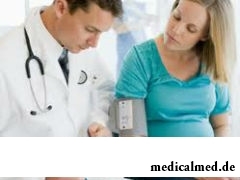





Eclampsia
 Eclampsia – the late form of a gestosis which is characterized by sharp rise in the arterial pressure posing threat to life to mother and a fruit. A gestosis – the disturbance of the normal course of pregnancy which is shown disturbance of functioning of systems of an organism. The eclampsia can develop to, in time and after pregnancy.
Eclampsia – the late form of a gestosis which is characterized by sharp rise in the arterial pressure posing threat to life to mother and a fruit. A gestosis – the disturbance of the normal course of pregnancy which is shown disturbance of functioning of systems of an organism. The eclampsia can develop to, in time and after pregnancy.
Eclampsia: reasons of development of a disease
The eclampsia is the most severe form of a gestosis, TsNS which is characterized by disturbance of activity and at untimely stopping of symptoms – a coma and the death of mother and a fruit. Now there is no consensus about the reasons of development of an eclampsia. The eclampsia is not an independent disease, and represents the irregular combined shape of a gestosis. There are about 30 theories of emergence of a state from which also distinguish the virus nature of disturbance.
Distinguish from the main reasons for development of eklampsichesky states:
- Defects of genes;
- Infections;
- Thrombophilias.
Today there is no test capable to authentically predict development of an eclampsia of pregnant women. The eclampsia generally develops after 22 weeks of pregnancy that is caused by pre-natal fetation. To this term the fruit is not capable to survival out of mother's womb because of incomplete formation of the highest structures of a brain. On the 22nd week of development in a fruit for the first time there are neurospecific proteinaceous connections which at penetration through the damaged placental barrier cause the system immune inflammation which is characterized by a vasospasm. It explains development of an eclampsia against the background of fetoplacental insufficiency (the state caused by dysfunction of a placenta).
The condition of an eclampsia is preceded by a preeclampsia which is characterized by the high arterial pressure, availability of protein in blood, nausea, a headache, disturbance of reflexes. The preeclampsia demands medical control and timely correction of symptoms. The only thing efficiently of treatment of an eclampsia is delivery.
The eclampsia is specific injury of a brain at gestoses when it is at the same time observed:
- Critical decrease in cerebral circulation;
- Brain ischemia;
- Loss of self-control of cerebral circulation;
- Cytotoxic wet brain;
- Disturbance of a cellular ionic hemostasis, functioning of structures of a brain, emission of the toxic neurotransmitters and stressorny genes provoking approach of unconsciousnesses, a convulsive syndrome, pregnant woman's coma.
These factors explain features of development of an eclampsia:
- Emergence rarity (the state is shown only at 5% of pregnant women);
- Molniyenosnost of development of symptomatology and critical states of the pregnant woman.
Algorithm of development of an eclampsia following:
- The long gestosis (which is often characterized by a heavy current);
- Preeclampsia (optional stage);
- Short-term loss of consciousness;
- Tonic, clonic spasms;
- Recovery (after delivery).
In certain cases the eclampsia can have very serious consequences as comas, functional insufficiency of kidneys, a liver, lungs or in extreme cases – brain death. During an eklampsichesky attack the hypoxia of a fruit and its death can develop.
Eclampsia of pregnant women: risk factors
There are certain risk factors of development of an eclampsia of pregnant women from which distinguish:
- Early, as well as late (after 40 years) the first pregnancy;
- Eclampsia in the family anamnesis;
- Obesity;
- Polycarpous pregnancy;
- Chronic diseases (diabetes, hypertensia, diseases of kidneys and cardiovascular system, anti-phospholipidic syndrome);
- Time interval between childbirth of 10 years and more.
Allocate also a number of the factors provoking development of an eclampsia of pregnant women:
- Improper feeding;
- The weakened uterine blood circulation;
- Disturbance of water-salt balance of an organism of the pregnant woman.
Puerperal eclampsia: probability of development
The probability of development of an eclampsia in the pregnant woman makes:
- During pregnancy – from 67 to 75%;
- In labor – to 25%;
- In a puerperal period – 1-2%.
As a rule, the puerperal eclampsia develops in the first 48 hours after the delivery, after end of this period the risk of development of a state is minimum. The puerperal eklampsichesky state is caused by hemodynamic, metabolic, hypoxemic frustration of an organism during incubation of a fruit. Symptoms of an eclampsia are after the delivery similar to a symptom complex of a prenatal and patrimonial eclampsia. Also approach of a puerperal eclampsia can be provoked by painful shock and external factors (bright light, a loud sound).
Eclampsia symptoms
The main symptoms of an eclampsia are:
- Small reductions of muscles;
- Tonic myotonia of skeletal muscles;
- Clonic myotonia of a trunk;
- Short-term loss of consciousness;
- Cyanosis (posineniye of integuments and mucous membranes);
- Eklampsichesky coma.
Other symptoms of an eclampsia are also the breath irregularity (development of asphyxia), foam from a mouth, is frequent with blood impurity.
Symptoms of the coming attack of an eclampsia are:
- The increased drowsiness, weakness;
- Nausea, the uncontrollable vomiting which is not caused by other causes;
- Increase in arterial pressure;
- Development of hypostases;
- Disturbances of visual function (indistinct sight, "front sights" before eyes);
- Proteinuria (availability of protein in urine).
The eclampsia can be shown by both one long attack, and a number of short-term attacks.
Treatment of an eclampsia: forecasts and methods
The forecast in treatment of an eclampsia is defined by a number of the following factors:
- Weight of a condition of the pregnant woman (the expressed hypostases, composition of urine, level of arterial pressure);
- Frequency of approach of attacks, their weight;
- Timeliness of assistance and stopping of attacks;
- The complications caused by attacks.
 At suspicion of an eclampsia at the pregnant woman continuous monitoring of arterial pressure, a hemodynamics of mother and a fruit is conducted. The electrolyte-deficient diet is shown to patients.
At suspicion of an eclampsia at the pregnant woman continuous monitoring of arterial pressure, a hemodynamics of mother and a fruit is conducted. The electrolyte-deficient diet is shown to patients.
The termination of attacks, increase in an otkhozhdeniye of urine is a good sign that will allow to postpone need of immediate delivery.
Temperature increase, arrhythmia, sharp lowering of arterial pressure after hypertensia are indications to immediate delivery.
The main treatment of an eclampsia consists in simplification of a symptomatic complex:
- Stopping of an attack and elimination of a vascular spasm;
- Normalization of pressure;
- Blood oxygenation;
- The dehydrational therapy promoting strengthening of an urination and reduction of puffiness.
At an eklampsichesky attack the intensive care which has character of cardiopulmonary resuscitation in combination with the therapy directed to recovery of function of a brain that allows to warn repeated attacks is applied.
The decision on delivery is made depending on weight of a gestosis and a condition of the patient during an eklampsichesky attack.
People who got used to have breakfast regularly have obesity much less often.

Work of a brain is extremely complex and in many respects is not studied yet. It is confirmed also by the features of thought processes which are shown in...
Section: Articles about health
The state of health of the person in many respects depends on food. The organism will well function if during food it receive only useful substances, necessary vitamins and microelements. In this case there will be no problems with digestion, with лишн...
Section: Articles about health
The thought that the mass of their body is too big at least once in life visits from 80 to 95% of women. Many women are so obsessed with this idea that constantly try all new and new ways of weight reduction. A considerable part of these techniques is ineffective, and some in general are unsafe for health....
Section: Articles about health
Health and attractiveness - eternal values, pursuing which people often use the most unusual ingredients and technicians...
Section: Articles about health
What they, women? Beautiful, gentle, passionate and at the same time windy, gusty, and nervous. And what is stranger: have all these qualities of the woman at the same time. But here only the mood their time sharply changes on completely opposite: in the morning...
Section: Articles about health
Neurosis is called pathology of a nervous system at which deviations in functioning of the highest nervous processes are observed. Most often - owing to yet not strengthened mentality - children are subject to neurosises. The unhealthy, hostile atmosphere in collective, a family, the strong and sharp shock, and also a set of other factors which negatively influence the little person who did not learn to overcome stresses yet can become premises to emergence of such disturbances....
Section: Articles about health
The sclera and mucous membrane of an eye are intensively supplied with blood vessels which problem - to sate nervous tissues of body to a pitata...
Section: Articles about health
Cystitis, or inflammation of a mucous membrane of a bladder, this very widespread disease which, owing to some features of a structure of bodies of urinogenital system, women have approximately four times more often than men. In the main risk group...
Section: Articles about health
Aspirin (acetylsalicylic acid) – one of those drugs which are known literally to all. It is available in each home first-aid kit, and many accept it at the first signs of an indisposition, often without having a fair idea of properties and therapeutic effect of drug. Meanwhile, impact of aspirin on a human body is very various, and is not always favorable. About it it is important to foreknow, in order to avoid emergence of problems with health....
Section: Articles about health
High temperature - a frequent symptom of such widespread diseases as a SARS, quinsy, pneumonia, etc. To reduce heat, облег...
Section: Articles about health
Cold is such painful that each sigh becomes a victory, heat "knocks" down, and the ache in joints forces to think only of pain. Some people with approach of the first symptoms of cold make the self-sacrificing decision to have a disease standing, and to a beam...
Section: Articles about health
Heart disease and blood vessels lead to disturbance of blood supply of bodies and fabrics that involves failures in their work, deterioration in health of the person, decrease in its working capacity and standard of living. Annually more than 17 million inhabitants of our planet perish from pathologies such....
Section: Articles about health
Wood louse – the ordinary-looking unpretentious plant extended in all territory of our country. It quickly expands, and sometimes fills sites, bringing a lot of chagrin to gardeners. Perhaps, they would be upset less if knew that the wood louse is valuable medicinal raw materials. A, C and E vitamins, organic acids, tannins, wax, saponins, lipids, mineral salts and essential oils are its part....
Section: Articles about health
Dogrose – one of the most widespread adornment and medicinal plants growing practically in all territory ours...
Section: Articles about health
80% of women at least once to lives complained of discomfortable feelings to breasts, consolidations and nagrubaniye. These are mastopathy symptoms. The mastopathy is characterized by change of a ratio between ferruterous and connective tissue tissues of mammary glands. It can bring...
Section: Articles about health
According to doctors, more than a half of men of 25-50 years suffer from frustration of the urinogenital sphere, but the minority sees a doctor from them. And in vain - even the insignificant discomfort in the field of generative organs can serve as a symptom of an illness fraught with grave consequences for health. So - after 40 years - it is easy for most widespread disease of the sexual sphere of men to pass the first symptoms of prostatitis (weight in the bottom of a stomach, decrease in a libido), having written off for overfatigue and fatigue. Let's consider...
Section: Articles about health
New year, wedding, birthday, office party – an occasion to drink at the Russian person will always be. How to reduce a negative impact...
Section: Articles about health
According to World Health Organization, every third inhabitant of Earth has excess weight, and every tenth has obesity. The reason of this phenomenon, according to specialists, roots in one not very comforting fact: most of people consume much...
Section: Articles about health
Sometimes it seems that modern society was divided into two camps: representatives of the first are sure that only the woman has to be responsible for contraception, representatives of the second, respectively, are sure that it is destiny of men. Meanwhile the question of contraception has very many aspects – both psychological, and legal and, of course, medical....
Section: Articles about health
Smack in a mouth can arise in the natural way – as a result of lack of morning hygiene or reception of the corresponding food. Odn...
Section: Articles about health
Milk and products of its processing by right occupy one of the main places in a diet of the modern person. They contain proteins, necessary for normal life activity, fats, vitamins and microelements, and are an important part of various medical diets....
Section: Articles about health
The number of long-livers is very small. One person from 5 thousand lives up to age of 90 years, and the centenary boundary steps over only one of 20 thousand. However, doctors claim that each of us is quite able to affect own destiny. At the same time it is not so much about living as long as possible, how many about an opportunity to keep physical and intellectual activity and to avoid decrepitude. We will also talk about the ways helping to achieve this result today....
Section: Articles about health
Olive oil – the product capable to make a powerful contribution to health of the person if it includes it in the diet. Rich vitamin...
Section: Articles about health
Life activity of one-celled fungi of the sort Candida, related to yeast is a proximate cause of development of candidiasis (milkwoman). Normal these microorganisms are a part of the microflora living in an oral cavity and intestines of most of people, and that...
Section: Articles about health
Women quite often suffer from complexes concerning the sizes of the bust. Strangely enough, not too modest, and excessively curvy shapes become the reason of sincere discomfort sometimes. Except psychological problems, the big bust sometimes creates also quite notable malfunctions with health: his owner can feel muscular dorsodynias, feeling of constant fatigue and difficulty of breath. Over time excess loading leads to development of diseases позвоночн...
Section: Articles about health


